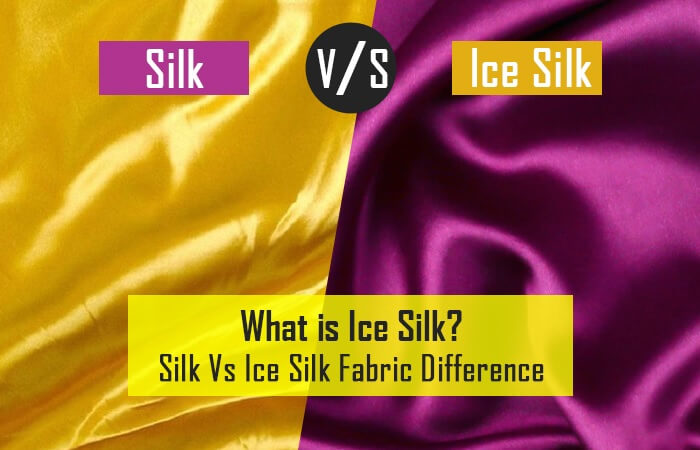Ice silk is not true silk; while both feel cool and comfortable, they are distinct fabrics. Ice silk is a synthetic material, known for its cool and smooth texture, while silk is a natural fiber produced by silkworms. These differences set them apart in terms of origin and properties.
What is Ice Silk?
During the summer season, the market is flooded with popular “ice silk” clothing. It’s not uncommon to discover that the washing label reads “ice silk,” while the fabric composition lists “viscose fiber” or “vegetable cellulose fiber,” often combined with other fibers like “polyester” or “spandex.” In reality, “ice silk” is essentially an enhanced version of viscose fiber, bearing a trade name due to its cool and comfortable properties in woven fabrics.
What are the advantages and disadvantages of ice silk?
Advantages: Ice silk fabric boasts an optimal moisture balance that harmonizes well with human skin’s needs, providing a silky-smooth and refreshing touch. It offers breathability, anti-static properties, UV protection, vibrant colors, and a soft texture akin to silk, all while maintaining excellent drape and shape retention.
Disadvantages: This fabric gets dirty easily and holds onto stains. When you wash it a lot, it might not look as good, and it can become stiff. To keep it soft, you need to use a special softening product. Also, it doesn’t handle exposure to acids and bases as well as cotton, so it’s best to use a gentle, neutral softener when washing it.
Silk VS Ice Silk Fabric Difference
| Characteristic | Silk Fabric | Ice Silk Fabric |
|---|---|---|
| Material | Natural fiber derived from silkworms | Synthetic fiber, often polyester |
| Texture | Smooth and soft | Smooth and cool to the touch |
| Breathability | Breathable, regulates temperature | Highly breathable, wicks moisture |
| Insulation | Provides warmth | Lightweight and cooling |
| Durability | Delicate and prone to snags | More durable and resistant to snags |
| Maintenance | Requires delicate care | Easier to care for, machine washable |
| Cost | Expensive | More affordable |
| Allergies | Hypoallergenic, less likely to cause allergies | Potential allergen for some people |
| Uses | Luxury clothing, bedding, and accessories | Athletic wear, activewear, summer clothing |
Here are some key differences between traditional silk and ice silk fabric:
1. Material:
- Silk: Traditional silk is a natural protein fiber obtained from the cocoons of silkworms. It is known for its softness, sheen, and luxurious feel.
- Ice Silk: Ice silk is a synthetic fabric made from materials like polyester and spandex. It is engineered to have cooling properties, making it comfortable in hot conditions.
2. Texture and Feel:
- Silk: Natural silk has a smooth, soft, and luxurious texture, with a natural sheen.
- Ice Silk: Ice silk is lightweight and often described as silky to the touch, although it may not have the same level of sheen and softness as natural silk.
3. Cooling Properties:
- Silk: Natural silk is known for its natural temperature-regulating properties. It can keep you warm in cooler weather and cool in warmer weather, making it a versatile fabric.
- Ice Silk: Ice silk is designed specifically for cooling. It is moisture-wicking and breathable, helping to keep you cool in hot weather.
4. Cost:
- Silk: Natural silk is generally more expensive due to the labor-intensive process of silkworm farming and silk production.
- Ice Silk: Ice silk is more affordable because it is a synthetic fabric.
5. Maintenance:
- Silk: Natural silk requires more delicate care, such as handwashing or dry cleaning, to maintain its quality and luster.
- Ice Silk: Ice silk is often machine washable and easier to care for.
6. Use:
- Silk: Natural silk is often used for high-end clothing, lingerie, and bedding.
- Ice Silk: Ice silk is commonly used for sportswear, casual clothing, activewear, and undergarments, especially in hot and humid climates.
Ice Silk and Silk Which is Better?
Silk is the winner here! Even though ice silk is nice and cool, it can’t beat the “fiber queen” – silk.
Silk, particularly mulberry silk, is a special kind of fabric made from proteins. It has 18 amino acids that are good for our bodies. It’s a natural and eco-friendly material that can help your skin stay healthy, keeping it moist and soft. Silk also has properties that can stop things like bugs and mold from growing on it. This makes it useful for preventing allergies and keeping you comfortable, especially during spring when allergies can be a problem.
FAQs:
1. Are both silk and ice silk fabric breathable?
Yes, both are breathable. Silk regulates temperature, while ice silk fabric is highly breathable and wicks moisture.
2. How do the textures of silk and ice silk fabric differ?
Silk has a smooth and soft texture, while ice silk fabric feels smooth and cool to the touch.
3. How do they differ in terms of maintenance?
Silk requires delicate care and is often dry clean only, whereas ice silk fabric is easier to care for and is typically machine washable.
4. Which one is more cost-effective, silk, or ice silk fabric?
Silk is generally more expensive, while ice silk fabric is more affordable.
5. What are the typical uses of silk and ice silk fabric?
Silk is commonly used for luxury clothing, bedding, and accessories, while ice silk fabric is popular in athletic wear, activewear, and summer clothing.
6. Are there any considerations for allergies with these fabrics?
Silk is hypoallergenic and less likely to cause allergies, while ice silk fabric can potentially cause allergies in some people.
Rose Frank
Latest posts by Rose Frank (see all)
- Knitting with Rayon Yarn: Properties & Patterns - May 3, 2024
- Knitting with Polyester Yarn: Properties & Patterns - February 20, 2024
- Different Types of Fabric: Names of Cloth Materials - February 1, 2024
